 |
 |
 |
| |
Similarity in Efficacy and Safety of Abacavir/Lamivudine (ABC/3TC) Compared to Tenofovir/Emtricitabine (TDF/FTC) in Combination with QD Lopinavir/Ritonavir (LPV/r) Over 96 Weeks in the HEAT Study
|
| |
| |
Reported by Jules Levin
IAC, Aug 3-8, 2008, Mexico City
From Jules: As you know by know there was controversy and much discussion at this conference over that ACTG 5202 found a higher rate of virological failures in patients with >100,000 c/ml viral load at baseline for abacavir/3TC compared with tenofovir/FTC. And as a result the DSMB recommended to the 5202 to stop that part of the study, in patients with baseline viral load >100,000. HEAT is a smaller study (688 in HEAT, 1858 in ACTG 5202) and the HEAT results were originally reported a year ago. Here is an analysis that was presented in a poster that includes a look at CVD biomarkers and viral responses in patients over 100,000 c/ml at baseline, which was presented here at IAC by GSK to show alongside the 5202 presentation. It was suggested that perhaps using Kaletra my have affected some outcomes as compared to 5202 where they used efavirenz and Reyataz.
Kimberly Y. Smith1, Derek Fine2, Parul Patel3, Nicholaos C. Bellos4, Louis Sloan5, Phillip Lackey6, Princy N. Kumar7,
Denise H. Sutherland-Phillips3, Cindy Vavro3, Linda Yau3, and Mark S. Shaefer3
1Rush University Medical Center, Chicago, IL, US; 2Johns Hopkins University School of Medicine, Baltimore, MD, US; 3GlaxoSmithKline, RTP, NC, US; 4Southwest Infectious Disease Associates, Dallas, TX, US;
5North Texas Infectious Disease Consultants, Dallas, TX, US; 6ID Consultants, Charlotte, NC, US; 7Georgetown University, Washington, D.C., US
AUTHOR DISCUSSION
ABC/3TC remained virologically comparable to TDF/FTC through 96 weeks
when each was combined with LPV/r.
--60% vs. 58% of subjects (ABC/3TC vs. TDF/FTC) achieved an HIV-1 RNA
<50 c/mL at Week 96 (ITT-E, M=F, switch included).
--64% vs. 61% of subjects (ABC/3TC vs. TDF/FTC) achieved an HIV-1 RNA
<400 c/mL at Week 96 (ITT-E, M=F, switch included).
Consistent results were noted in antiviral response rates (HIV-1 RNA <50
c/mL) by increasing baseline viral load strata.
Median CD4+ cell responses were similar at Week 96
(466 cells/mm3 for ABC/3TC and 445 cells/mm3 for TDF/FTC).
A conservative protocol definition of virologic failure resulted in a
somewhat elevated virologic failure rate in both arms.
Similar tolerability was noted for both regimens with no new safety findings
observed.
--Rate of ABC HSR was 4% with ABC/3TC and 1% with TDF/FTC.
Prospective HLA-B*5701 screening was not performed in this study.
--PRTD occurred in 0% with ABC/3TC and 1% with TDF/FTC.
--Lipid elevations were observed in both arms; TC:HDL ratio remained
<5 for each.
Decreases were seen in both interleukin-6 and highly sensitivity CRP; while
these changes may be attributable to antiviral suppression, no differences
were seen between the treatment arms.
Author Conclusions
ABC/3TC is comparable to TDF/FTC in virologic efficacy and safety
when combined with LPV/r through 96 weeks.
Both treatment regimens were well tolerated with few discontinuations
due to adverse events in either arm.
INTRODUCTION
Limited direct comparative data exist between the recommended dual NRTI
fixed dose combinations, ABC/3TC and TDF/FTC.
The HEAT study is the first completed head-to-head trial to evaluate the
efficacy and safety of these dual NRTI backbones with a boosted PI as part of recommended first-line treatments in HIV-1 infected subjects.
OBJECTIVES
To establish that ABC/3TC is virologically noninferior to TDF/FTC when
administered in combination with LPV/r over 48 weeks.
To compare the safety and tolerability of ABC/3TC versus TDF/FTC over
96 weeks.
Methods
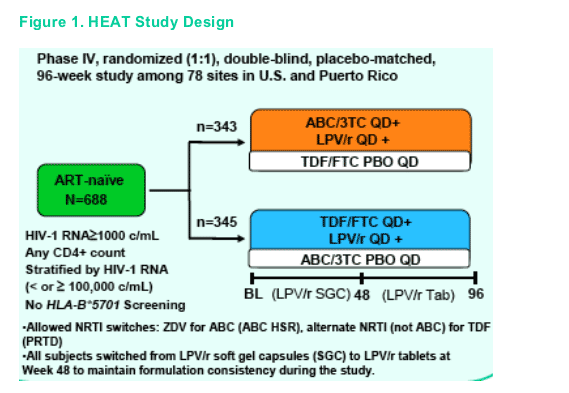
Protocol-Defined Virological Failure
Failure to achieve HIV-1 RNA <200 c/mL or confirmed rebound to ≥ 200 c/mL
after confirmed reduction to <50 c/mL by Week 24.
Confirmed HIV-1 RNA ≥ 200 c/mL after Week 24.
Statistical Analysis
Non-inferiority of ABC/3TC compared to TDF/FTC was established if the lower bound of the two-sided 95% CI on the difference in proportions achieving an HIV-1 RNA <50 c/mL at Week 48 was -0.12 or greater [ITT-E, missing=failure, switch included].
Virologic response rates were compared between arms by the Cochran-
Mantel-Haenszel test stratified by baseline HIV-1 RNA (< or ≥100,000 c/mL).
Efficacy and Safety analyses were based on the ITT(E) population.
RESULTS
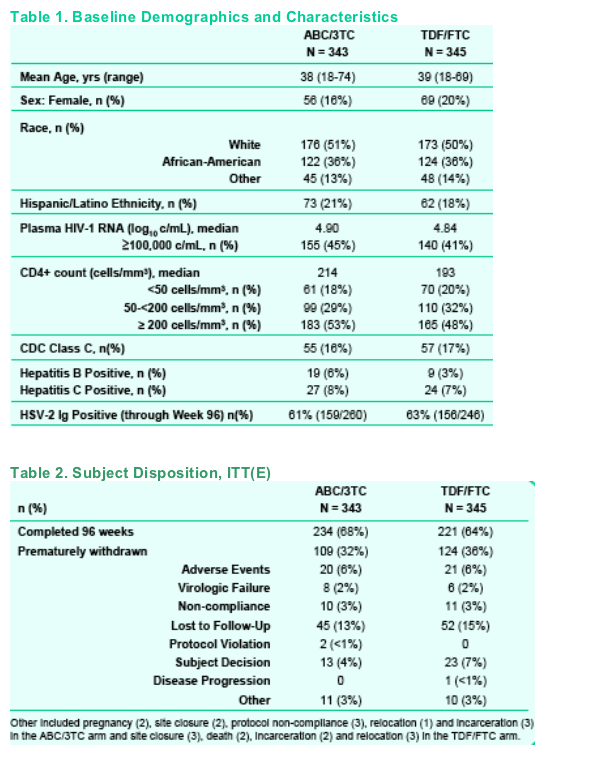
Protocol-Allowable Toxicity Switches
NRTI switches included suspected ABC HSR [14 (4%) ABC/3TC; 3 (1%) TDF/FTC] and Proximal Renal Tubule Dysfunction (PRTD) [0 ABC/3TC; 5 (1%) TDF/FTC].
-- PRTD definition: serum creatinine rise of ≥0.5 mg/dL from BL and serum
phosphate <2 mg/dL or either of the former plus any 2 of the following: proteinuria ≥100 mg/dL, glycosuria ≥250 g/dL, low serum potassium
<3 meQ/L, or low serum bicarbonate <19 meQ/L.
For PI-induced GI intolerability, LPV/r was permitted to be dosed twice daily.
For treatment-limiting PI toxicity, LPV/r could be switched to FPV.
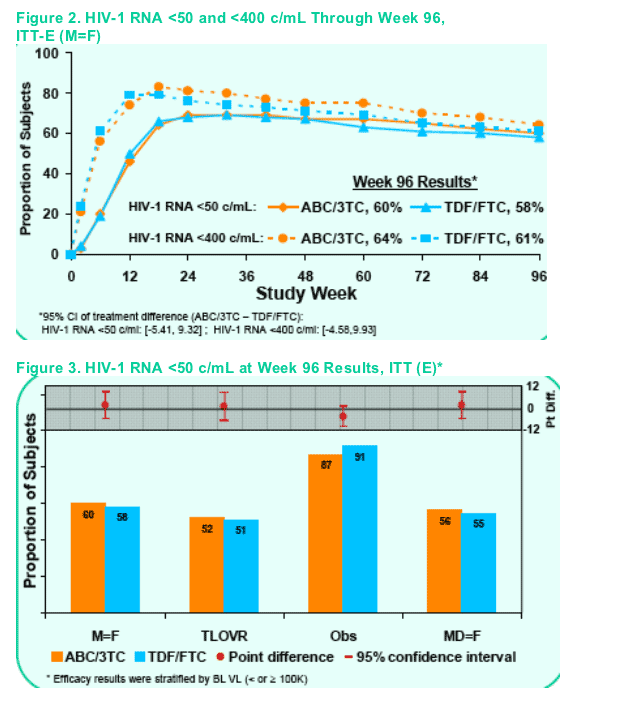
These results corroborate the virologic non-inferiority of ABC/3TC to TDF/FTC that was demonstrated at 48 Weeks.
Consistent results were observed regardless of analysis method used including when switches were counted as failures (MD=F analysis).
Protocol defined virologic failure was experienced by 14% of subjects in each treatment arm (ABC3TC: 49/343; TDF/FTC: 48/345) through 96 weeks.
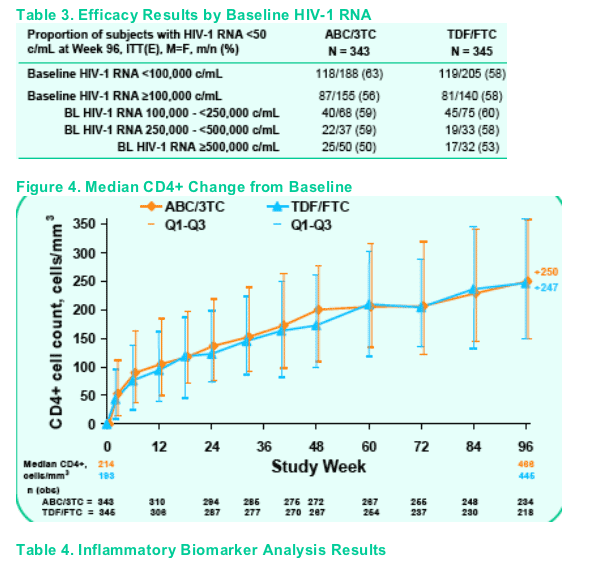
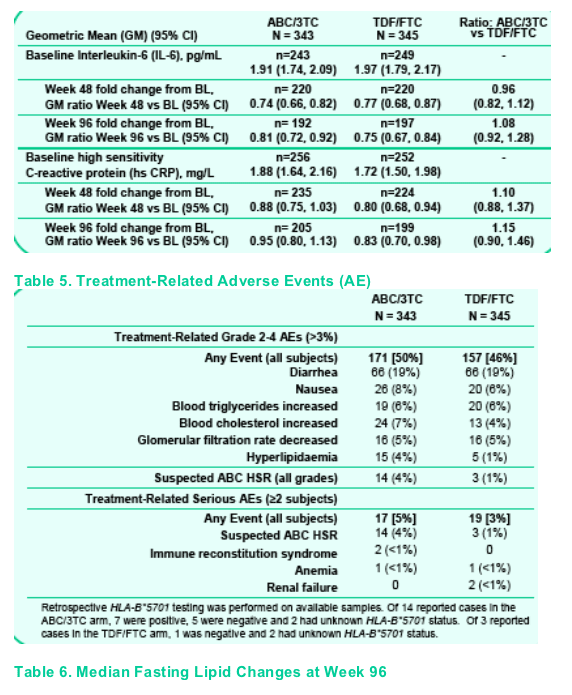
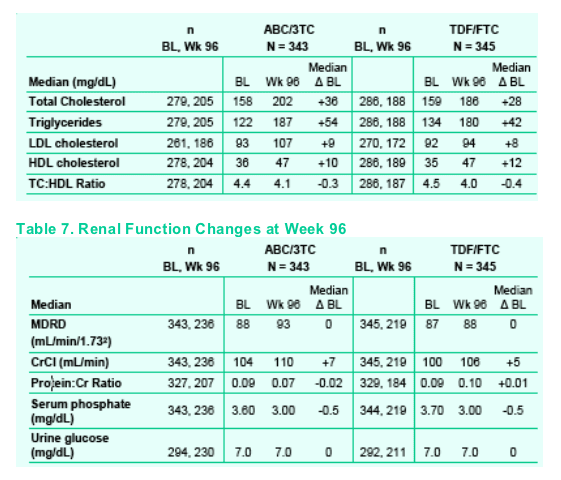
|
| |
|
 |
 |
|
|